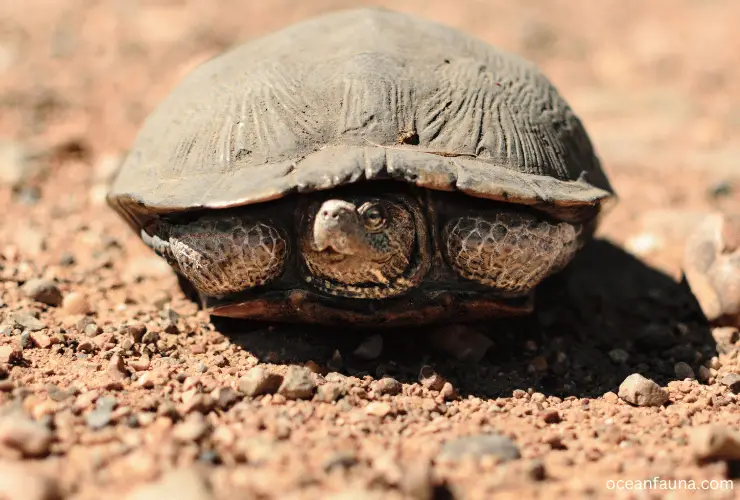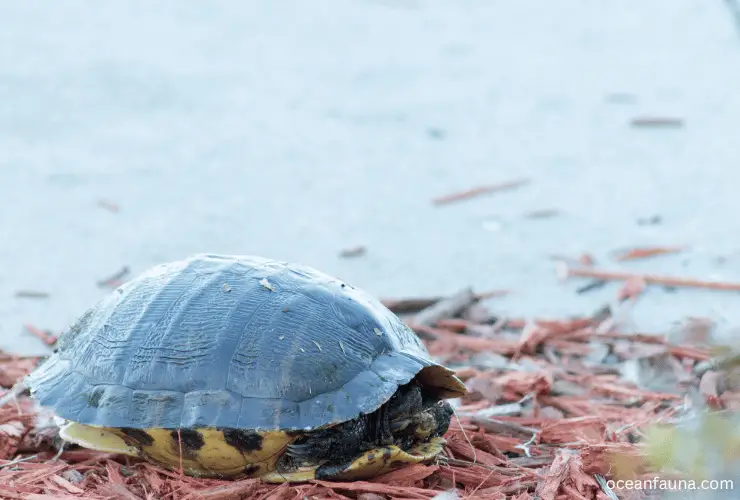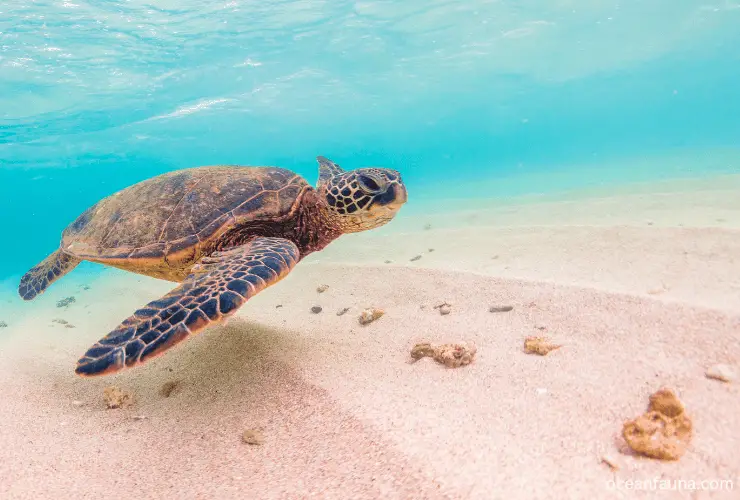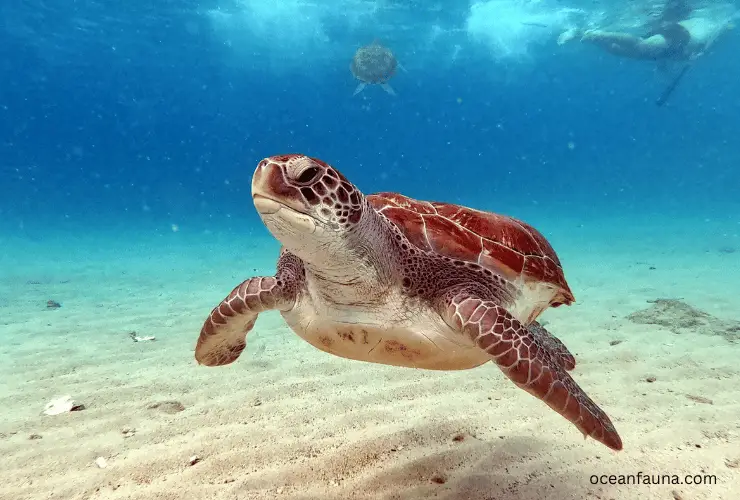No, sea turtles can’t hide in their shells. Unlike their relatives, such as land turtles and tortoises, sea turtles cannot hide in their shells for protection. This is because a sea turtle’s anatomy is adapted to being underwater. As a result, it cannot hide inside its flat shell.
Even though sea turtles can’t hide in their shells for protection, they still have other defense mechanisms. These include its solid, strong, and durable shell, the ability to camouflage, and even the ability to swim away swiftly from any potential threats or dangers.
Knowing that a sea turtle does not hide in its shell, let’s get into more information about the anatomy of a sea turtle and its defense mechanisms!
What Does It Mean When a Turtle “Hides”?
When a turtle hides in its shell, it quite literally retracts its head, limbs, and tail into its shell and “retreats” or “hides.”

The most obvious answer to why turtles hide is that this is their defensive mechanism against any potential predators and threats. When a turtle hides in its shell, it becomes less exposed to danger, making it more challenging for predators to access its softer body parts.
This behavior is followed by the turtle closing its shell openings with its limbs, helping to create a tighter seal. The shell is used as a shield, as it provides a protective covering to help protect the most vulnerable parts of its body.
Additionally, this behavior to hide is a temporary strategy, and turtles will eventually come out of their shells once they know that the threat has passed or the environment is safe.
When a turtle “hides,” it’s just using a natural and effective defense mechanism to increase its chances of survival in the face of potential danger.
Can Sea Turtles Hide in Their Shells?

Even though sea turtles are related to other normal turtles and tortoises, they have some very weird and unexpected differences. The most notable one is that they cannot hide in their shells.
Despite being closely related to tortoises and turtles, sea turtles have some other means of self-defense, including their hard shell.
Although sea turtles cannot conceal themselves inside their shells, the shell is still strong enough to keep the turtle safe. They also often display behaviors like camouflage and swift swimming to save themselves from any potential threats.
Why Can’t Sea Turtles Hide in Their Shells?
Now that we have learned so far that sea turtles cannot hide in their shells, you might be wondering why that is. Here are some reasons why these kinds of turtles can’t hide in their shells.
- Firstly, a sea turtle’s anatomy is quite different from that of other tortoises and turtles, whose bodies are not used to being underwater. Their shells are streamlined and flattened, which helps sea turtles swim in the water. Due to this shape, a sea turtle just doesn’t have enough space to duck its head inside its shell like other normal turtles and tortoises.
- Secondly, unlike land turtles with more flexible anatomy, the structure of a sea turtle’s shoulders and hips limits its ability to retract its limbs fully into the shell.
- Lastly, sea turtles don’t even need to hide in their shells because they’re made in such a way that they need to be agile swimmers to navigate currents and find food and barely require the ability to withdraw into a shell.
What Are the Dangers For Sea Turtles If They Can Not Hide In Their Shells?

Sea turtles are pretty vulnerable to a lot of attacks. They face a lot of danger due to their inability to hide in their shells. Here are some of them listed:
- The number one danger that they are exposed to is their vulnerability to predators. Without the protective shell retreat mechanism, they have to rely on other strategies to avoid being preyed upon. They mostly use their size and speed to escape potential dangers. They may also camouflage themselves to blend into their surroundings.
- Another danger sea turtles face is human interaction. Sea turtles may experience getting trapped or hunted in fishnets, crashing into boats, or may end up swallowing plastic. Without being able to hide in their shells, they are more vulnerable to getting injured due to human activities.
- Another danger that is also caused by humans is the destruction and alteration of their habitats. Human development and climate change have affected the availability of safe spaces for sea turtles. Their inability to hide in their shells increases the risks they face in their habitats.
- Climate change affects almost all the animals that live on Earth. Rising sea temperatures and ocean acidification impact the availability of food sources and destroy their habitats. Sea turtles may face challenges adapting to these changes without the protective capability of retracting into their shells.
Sea turtles face these challenges every day. This means that sea turtles have other ways they can protect themselves from these dangers.
What Are the Types of Turtles That Can Hide In Their Shells?

There are several kinds of other turtles that can retract into their shells. However, not all of these pieces have the same ability to retract at the same level.
Some can fully withdraw their heads and limbs, while most others have more limited retreat abilities due to their specific shell structure.
There are about 356 species of turtles. Out of those, there are two main types with two different ways of ducking their limbs and heads in their shells.
What Are the Other Types Of Turtles That Can Not Hide In Their Shells?
Sea turtles are not the only species that cannot hide in their shells. Some turtles and tortoises can’t hide their bodies in their shells to protect themselves.
Here are some examples of turtles that can’t hide in their shells. These include sea, snapping, matamata, and fly river turtles, and more!
All these species live in different areas with adaptations related to their habitats or have different defense mechanisms that do not require hiding under their shells.
FAQs
How long can a turtle shell last?
After a turtle has died, its limbs and head only take a couple of days to decompose. However, its shell takes a long time to decompose. Its shell lasts for about 50 years after its death!
How Does the Shell of A Sea Turtle Differ From The Shell of A Land Turtle?
A sea turtle’s shell is quite different and displays distinct differences from that of land turtles. Unlike a land turtle’s shell, sea turtle shells are streamlined and flatter, lighter and more flexible, and have fewer bones, helping the turtle glide through the water.
Do Sea Turtles Use Their Shells for Defense?
Yes, sea turtles use their shells for defense. As sea turtles grow older, their shells get tougher and act as a shield, protecting them from predators and making it more difficult for them to be eaten by them.
Can turtles lose their shells?
No, turtles can’t lose their shells. This is because, just like our bones are a part of us, a turtle’s shell is a part of them. Their nerves, skin, ribs, and spinal cord are all linked to the shell. However, a turtle’s shell can be cracked or broken.
Do turtle shells grow?
Yes, technically, a turtle’s shell does grow. In many aquatic species, as the turtle gets bigger, a thin layer of tissue called the epithelium grows a new scute (an outer plate made of bone) beneath the existing one. This new scute has a larger diameter than the one on top of it. This process helps the shell expand as the turtle and its shell grow.
Conclusion
To sum up, sea turtles cannot hide within their shells for protection, unlike their relatives. They have evolved anatomy adapted for aquatic life. They have flat and streamlined shells to help them swim freely in the ocean.
Even though they can’t hide in their shells, sea turtles have other defense mechanisms. Their durable and strong shells offer protection. To protect themselves from harm, they can conceal themselves and swim quickly.

